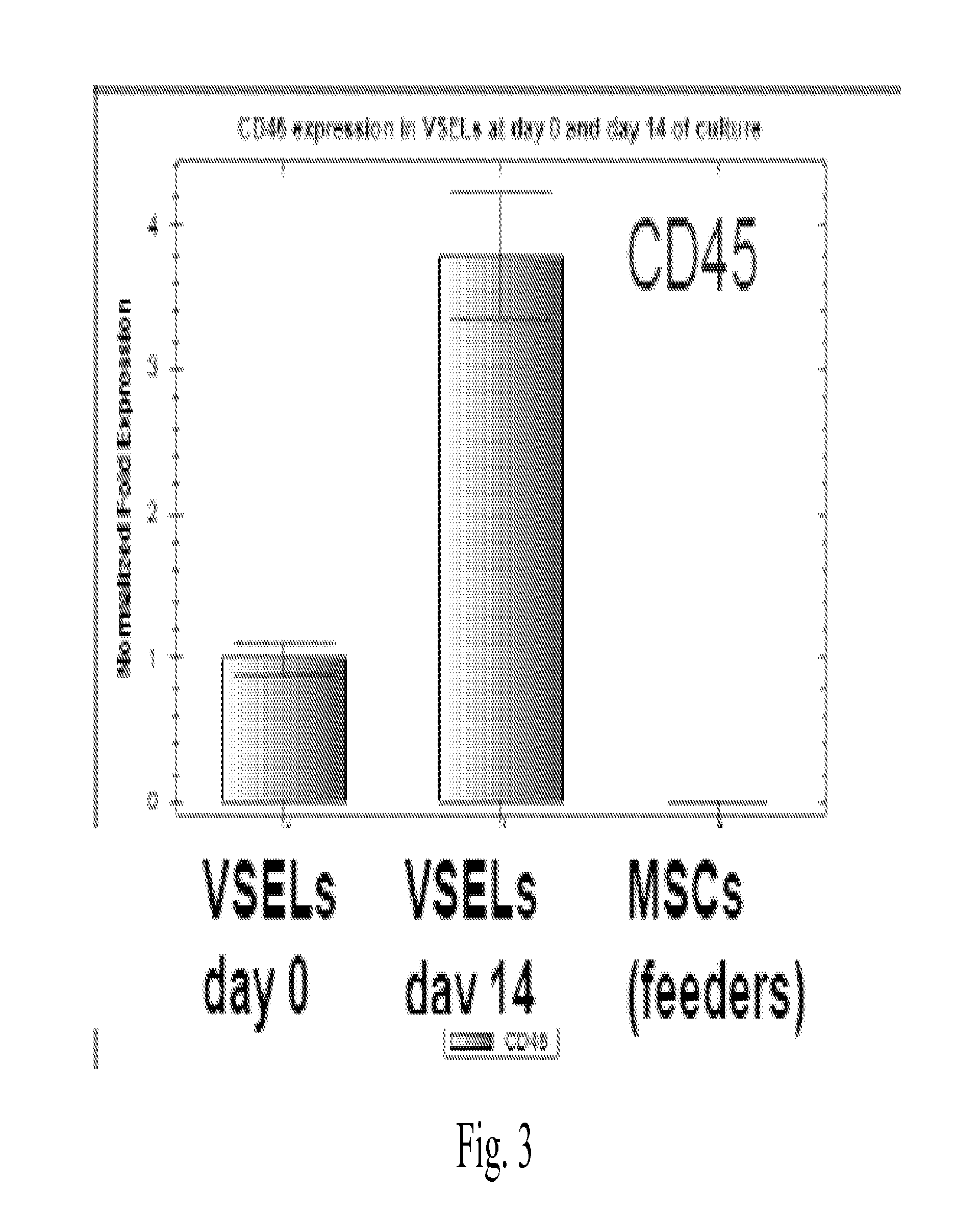Stem cell treatment for radiation exposure
- Summary
- Abstract
- Description
- Claims
- Application Information
AI Technical Summary
Benefits of technology
Problems solved by technology
Method used
Image
Examples
example 1
Irradiated VSELs Rescue Hematopoietic System of Irradiated Mice
[0064]Twenty adult male or female transgenic GFP C57BL / 6 mice (4-8 weeks old; Jackson Labs) are exposed to a lethal dose (950 cGy) of irradiation. This extreme level of radiation assures that any viable stem cells isolated are only VSELs.
[0065]Four days after irradiation, the mice are sacrificed and VSELs isolated from BM by FACS (see, Ratajczak et al., 2011, Exp. Hematol. 39:225). The murine GFP-VSELs are then in subjected to expansion (culturing in methylcellulose plates) and priming (co-culturing over OP9 cells) over a 5-10 day period as described in Ratajczak et al., 2011. The OP9-primed VSELs are isolated by FACS and administered (105 cells) either by tail vein injection or intrafemural administration to C57Bl6 mice (20 mice per group), 24 hrs after being subjected to sublethal (250 cGy) or lethal whole body irradiation (950 cGy). As controls, separate groups of mice (20 per group): i) receive no cell therapy (they ...
example 2
Human VSELs Rescue Hematopoietic System of Lethally Irradiated Mice
[0068]Resistance of hVSELs to X-irradiation in vitro. Healthy volunteers are treated with G-CSF (480 μg) two consecutive days to mobilize the VSELs from the BM to peripheral blood and blood (200-300 ml) is collected. To isolate hVSELs, following G-CSF treatment, total nucleated cells are collected by apheresis, and subjected to size-based separation and FACS. The cells are subject to multiple analyses including RT-PCR and fluorescence labeling. RT-PCR is used to analyze expression of Oct4, Nanog, Nkx2.5 / Csx, VE-cadherin, and GFAP mRNA levels. Fluorescent staining of hVSELs is used to measure expression of CXCR4, lin, CD45, SSEA-4, Oct-4 and Nanog.
[0069]The hVSELs are cultured in vitro and exposed to different doses of X-irradiation. Cell viability is assessed by almarBlue staining, cell counting and in BrdU labeling studies to measure proliferation. Viable cells are tested to determine whether they can be directed to...
example 3
Irradiated VSELs Rescue Lethally Irradiated Mice
[0074]Ten adult male or female transgenic GFP C57BL / 6 mice were exposed to a lethal dose (950 cGy) of irradiation. This extreme level of radiation assured that any viable stem cells isolated are only VSELs. The mice were sacrificed and VSELs (Sca-1+lin−CD45−) were isolated from BM by FACS. The murine GFP-VSELs were then co-cultured over OP9 cells for about 10 days. GFP-expressing donor cells were sorted by FACS and administered by tail vein injection to lethally irradiated recipient C57Bl / 6 mice. In a first experiment, recipient mice received 1×105 donor VSELs. All of the recipients died approximately 12 days post transplantation. The experiment was repeated using greater amounts of VSELs. In Experiment 2 (FIG. 6) and Experiment 3, recipient mice received 2×105 donor VSELs. In each of the second and third experiments, five of six recipients survived and became chimeric, while the sixth recipient died around 12 days post transplantation...
PUM
 Login to View More
Login to View More Abstract
Description
Claims
Application Information
 Login to View More
Login to View More - R&D Engineer
- R&D Manager
- IP Professional
- Industry Leading Data Capabilities
- Powerful AI technology
- Patent DNA Extraction
Browse by: Latest US Patents, China's latest patents, Technical Efficacy Thesaurus, Application Domain, Technology Topic, Popular Technical Reports.
© 2024 PatSnap. All rights reserved.Legal|Privacy policy|Modern Slavery Act Transparency Statement|Sitemap|About US| Contact US: help@patsnap.com










